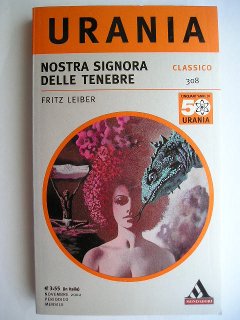
The novel “Our Lady of Darkness” by Fritz Leiber was published for the first time in 1977. Originally it was a shorter story titled “The Pale Brown Thing”, serialized in “The Magazine of Fantasy & Science Fiction” in 1974, which was later expanded into this novel. This longer version won the World Fantasy Award as best fantasy novel of the year.
Franz Westen is a writer of horror stories for television who lives in San Francisco. After his wife’s death he spent a period in which he was an alcoholic and is still trying to get out of that crisis.
By chance – but is it really a coincidence? – Franz starts reading a strange book about occult themes titled “Megapolisomancy: A New Science of Cities” written by the mysterious Thibaut De Castries. Initially, he takes it as a little peculiar literary work but when he sees a strange figure from his window he starts realizing that there are entities such as paramentals and they really haunt modern metropolis.
“Our Lady of Darkness” is the last novel written by Fritz Leiber, who in the last years of his life only wrote short fiction. The author had written stories of various genres mixing their elements and in this one he starts from a quite classic horror then he puts it in the setting of a modern metropolis.
In this case, San Francisco is the focus of the story and in “Our Lady of Darkness” some of its buildings are a central part of the plot. Fritz Leiber moved to San Francisco after his wife Jonquil’s death and for about three years battled with alcoholism so it’s clear that in the novel there are some autobiographical elements.
Fritz Leiber invented an occult art called megapolisomancy that allows the prediction and manipulation of the future through the existence of a metropolis. This art is theorized in a book written by an author also invented, Thibaut de Castries, whose fictional story is reconstructed in “Our Lady of Darkness”.
Fritz Leiber blends fictional elements invented by him with real ones. In particular, in “Our Lady of Darkness” there are many references to the relationship between the fictional writer Thibaut de Castries and writers who really existed such as H.P. Lovecraft, Jack London, Ambrose Bierce, Clark Ashton Smith, George Sterling and Adolphe De Castro. Real and fictional events are intertwined in such a way that sometimes it becomes difficult to tell them apart.
The novel’s title is a reference to the book “Suspiria de Profundis” by Thomas de Quincey, which introduces three sisters, “Our Ladies of Sorrow”: Mater Lacrimarum (Our Lady of Tears), Mater Suspiriorum (Our Lady of Sighs) and Mater Tenebrarum (Our Lady of Darkness). Also in 1977 the movie “Suspiria” by Dario Argento came in theaters, the first of the trilogy of “The Three Mothers” that also takes inspiration from “Suspiria de Profundis”.
Defining “Our Lady of Darkness” a novel on the theme of the supernatural or metropolitan horror is simplistic. In fact, Fritz Leiber creates a story that has supernatural elements included in a metropolitan setting but at the same time an important part is the protagonist’s search into the occult art of megapolisomancy and the life of the mysterious occultist Thibaut de Castries.
“Our Lady of Darkness” is therefore also an esoteric novel because the protagonist gradually discovers hidden truths that usually are revealed only to initiates through a series of secret teachings.
For this reason, if you expect to read a story that scares you at every page you’ll be disappointed because there are parts of “Our Lady of Darkness” that can be called philosophical in which the protagonist talks to his friends about megapolisomancy and the paramentals. Again, this isn’t simply a horror novel.
In this complex plot, the characters are sacrificed: in other novels, Fritz Leiber developed them very well, instead “Our Lady of Darkness” is under this point of view below the author’s average.
To me it’s always worth reading a novel by Fritz Leiber even when it’s not perfect. For its particular structure, I recommend “Our Lady of Darkness” to fans of the occult and esotericism rather than to those of classic horror.

